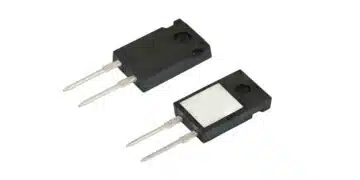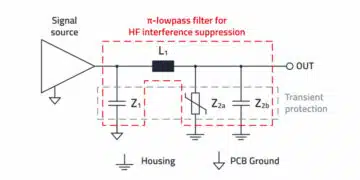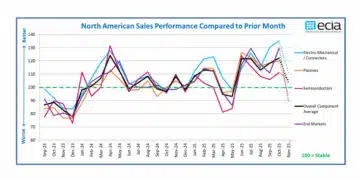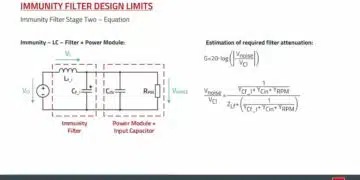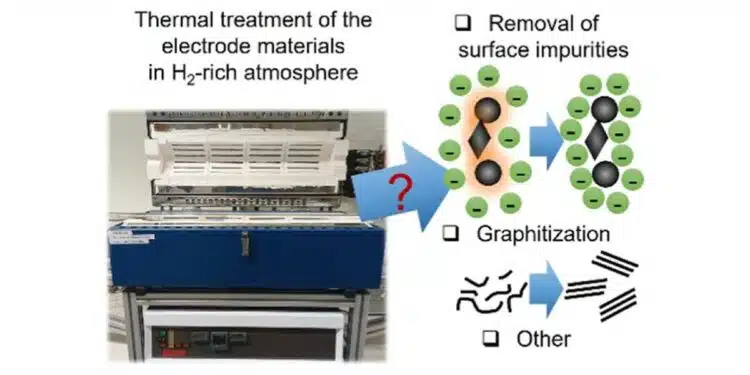Researchers from Italy published by ACS Appl. Mater. Interfaces conducted a systematic study of H2-assisted thermal treatment on activated carbon and corresponding electrodes for electrochemical double-layer supercapacitors (EDLCs).
The treatment improved EDLC performance by eliminating surface impurities, increasing surface capacitance, and altering active material and binder contents. This study provides insights into the relationship between electrode material modifications and EDLC performance.
Introduction:
Electrochemical Double-Layer Capacitors (EDLCs) are vital energy storage devices, relying on the electric double-layer mechanism at the interface of carbon-based electrodes and electrolytes.
This mechanism emphasizes the significance of high-surface-area carbon materials. However, current limitations in capacitance due to inaccessible micropores, quantum capacitance effects, and surface impurities hinder their full potential.
The study focuses on the role of hydrogen-assisted (H₂-assisted) thermal treatment in enhancing EDLC performance.
Key Points:
- Challenges in EDLCs: Limited capacitance due to micropores, quantum effects, and impurities.
- H₂-Assisted Thermal Treatment: A method to improve surface properties and capacitance.
- Experimental Approach: Systematic treatment of activated carbon electrodes at varying temperatures (500–800°C).
- Results: Up to 35% energy density improvement, with significant increases in surface and gravimetric capacitance.
- Conclusions: Enhanced EDLC performance through impurity removal and surface modification.
Extended Summary:
The article presents a comprehensive study on improving the performance of EDLCs through H₂-assisted thermal treatment of activated carbon electrodes. EDLCs store energy via ion adsorption at electrode interfaces, and their efficiency is influenced by the surface area, porosity, electronic properties, and the presence of surface contaminants.
The research addresses key limiting factors such as inaccessible micropores that restrict ion flow, quantum capacitance effects that reduce overall capacitance, and surface impurities like hydrocarbons and adsorbed species that form dielectric barriers. These barriers impede effective ion adsorption, thereby lowering the EDLC’s performance.
To tackle these issues, the study applies H₂-assisted thermal treatments to activated carbon electrodes, aiming to remove surface impurities and enhance the electrode’s electrochemical properties. The materials were treated at varying temperatures (500°C, 600°C, 700°C, and 800°C), and their chemical, structural, and thermal properties were analyzed using advanced characterization techniques including X-ray photoelectron spectroscopy, Raman spectroscopy, and thermogravimetric analysis.
The results illustrate that the thermal treatment leads to significant improvements in EDLC performance. Notably, the treated electrodes exhibited over 35% higher energy density compared to untreated ones. Surface capacitance (CsurfAC) improved by approximately 37% due to the removal of impurities, which reduced the dielectric barrier effect and enhanced ion accessibility. Gravimetric capacitance (CgAC), normalized to the activated carbon mass, also rose by 28%, demonstrating improved charge storage capacity.
Interestingly, the study challenges prior assumptions about graphitization during thermal treatment, finding that the observed performance gains are mainly due to impurity desorption rather than structural graphitization. The treated materials showed slight densification but retained high surface areas conducive to charge storage.
Conclusion:
The research confirms that H₂-assisted thermal treatment is an effective post-production process for enhancing EDLC electrode performance. This method improves both the chemical surface properties and electrochemical capabilities of activated carbon electrodes by eliminating surface impurities and optimizing active material content. These findings offer valuable insights for developing high-performance, energy-dense EDLCs, potentially advancing energy storage technologies.
Read the full paper:
Matteo Gentile, et col,. Bedimensional.it. Hydrogen-Assisted Thermal Treatment of Electrode Materials for Electrochemical Double-Layer Capacitors, ACS Appl. Mater. Interfaces 2024, 16, 11, 13706–13718, https://doi.org/10.1021/acsami.3c18629



